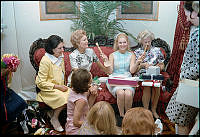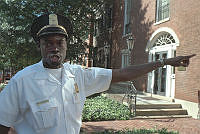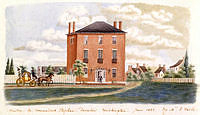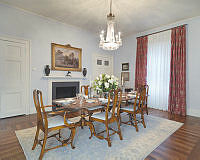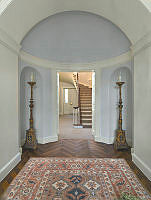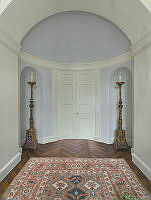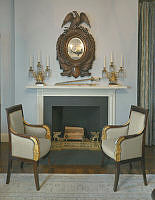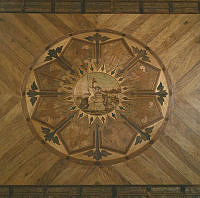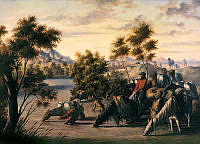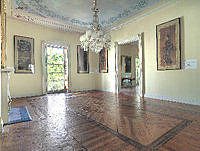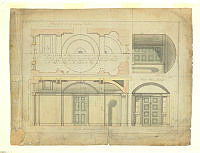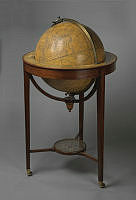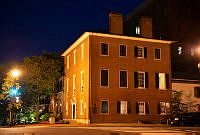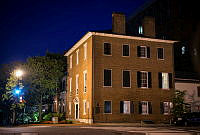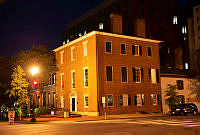Rubenstein Center Scholarship
“The Back Building”
An Architectural History of the Decatur House Slave Quarters
This article is part of the Slavery in the President’s Neighborhood initiative. Explore the Timeline

The January 1822 receipt for “Erecting the Back Building & finding materials for the same.”
National Archives and Records AdministrationBuilt in 1818-1819, Decatur House was designed by the English architect Benjamin Henry Latrobe for Commodore Stephen Decatur and Susan Decatur. Latrobe had previously sent proposals and estimates to Decatur in June 1817, along with this advice: “If the house should be occupied by a foreign Minister, I would also recommend the addition of a slight one story-room, for a servant’s hall.”1 The first documented mention of such a building appears in January 1822, when Susan Decatur received a bill for “erecting a building joining the House in President’s Square” for the sum of $1,309.85. Latrobe’s recommendation aligns with this addition, as the French Minister to the United States Baron Hyde de Neuville was renting the home from Susan at that time. While this does not tell us whether the building was one story or two, a dendrochronological analysis of wood samples taken from the first and second floors, as well as the attic, revealed a consistent set of years (1820-1822) for dating the felled wood. Construction likely took place in 1821-1822, and the receipt mentioned above was presented in January 1822.2 The first occupants of these spaces would have likely been the domestic staff of the French minister and any other hired workers—free or enslaved. The status of these early workers is unknown, though many foreign ministers employed workers from their native countries.

Room Number 1
David Ramsey/White House Historical AssociationIn 1827, Secretary of State Henry Clay rented the property and brought enslaved people with him from Kentucky, including Charlotte Dupuy (or Dupee) and her family. This was the first documented instance of enslaved people living at Decatur House. In 1836, John Gadsby purchased Decatur House for his retirement years. While he turned over operations of the National Hotel to his son William, Gadsby brought enslaved workers to his new house. The 1840 census recorded ten enslaved people living at Decatur House, along with two free Black men. When Gadsby died in 1844, his property inventory listed twenty-one enslaved people, with two working off debt toward freedom. Seventeen of these individuals were bequeathed to John’s wife Providence, but fluctuations in numbers in 1850 and 1858 when Providence died suggest that some disappeared from the residence. Some were likely hired out to other households or businesses; some may have purchased freedom for themselves or family members; and some were likely separated from their families and sold. Because enslaved people often lived where they worked, most probably lived in the Slave Quarters as it was right above the kitchen and laundry. Some may have stayed inside the main house and slept in its hallways, the basement, or the attic. There was also a separate stable and carriage house, which may have housed enslaved workers along the back side of the property. As historian Michael Vlach noted, “the master’s house, its yard, and its servants’ quarters were…the prime components of an urban compound, a gathering of buildings that was readily distinguished from the homes of city residents who owned few or no slaves.”3

Room Number 2
David Ramsey/White House Historical AssociationThe architectural renderings of these four rooms of the Decatur House Slave Quarters are based primarily on the inventory taken on May 28, 1844. William Marshall and Richard Wright moved through the property and made note of the deceased’s possessions and goods. The men recorded three “servants room[s]” under the “Back Building” category, and identified them as numbers 1, 2, and 3. In all three rooms, there were an assortment of bedsteads, bedding, and chairs. While this inventory suggests that the Decatur House Slave Quarters only had beds, chairs, and bedding, it is worth noting that these appraisers valued items that belonged to Gadsby, not the enslaved people who were living there. Any handmade items or furnishings, or personal possessions such as clothing or family heirlooms, would not have been appraised. Items given to the enslaved such as damaged chinaware or cracked plates would have also gone unnoticed.

Room Number 3
David Ramsey/White House Historical AssociationWhile the inventory only specifically mentions three rooms for servants, there is also an assortment of household items listed for the “Back Building.” This includes one Brussels carpet, two rugs and a doormat, chamber carpeting, a bedstead, three mattresses, a copper kettle, two pairs of tongs and a shovel, loaves of white sugar, four dish covers, and one sieve. There is also mention of a stove, flat iron tubs, an “Iron Table in Laundry,” “Copper Utensils Tables,” and “Cutlery articles in Kitchen.”4 Some items were probably located in the downstairs kitchen and laundry, but because there is no designation for the fourth room on the second floor, it is depicted in our architectural renderings as a multipurpose room used for both storage and additional sleeping accommodations. It is possible that this room was used by hired out laborers or free Black workers, as well as enslaved members of the Gadsby household. A letter from 1865 confirms that there were four rooms on the second floor, as General Amos Eaton, Commissioner General of Subsistence, asked John McBlair, agent for the Gadsby heirs, for “permission to remove the partitions in the second story of the back building so as to throw the whole space occupied at present by the entry and four rooms, into two rooms.”5

Room Number 4
David Ramsey/White House Historical AssociationIn each of these renderings, the windows against the south wall overlook the Decatur House interior courtyard. Shutters conceal the enslaved people that lived and worked in these rooms, though some have suggested that the building had iron bars on its windows. Sarah Vedder, who published Reminiscences of the District of Columbia: Or, Washington City Seventy-Nine Years Ago, 1830-1909, claimed that the “jail, or ell” was where “Gadsby kept his negroes until they were sold to Georgia. It was a long, one-story brick, with windows barred with iron, and sometimes at night you could hear their howls and cries.”6 This story was repeated in Washington, City and Capital, published in 1937 as part of the Federal Writers’ Project of the Works Progress Administration. This publication also suggested that Gadsby used the interior courtyard as a slave market: “For a brief but regrettable period, about 1844, John Gadsby leased the property and made the garden at the rear of the house into a slave market, protected from sight by an 8-foot brick wall on the south and an ell adjoining the house on the H Street side. The ell, a long one-story brick building, its windows barred with iron, was used as a corral for Negro slaves.”7 Marie Beale, the last private owner of the house, repeated these references in her 1954 history of Decatur House but admitted that it might be “fanciful exaggeration.”8 While there is no documentation from John Gadsby’s time to verify these claims, there is likely some degree of truth to these statements. His buying and selling of enslaved people are irrefutable, and it is certainly possible that some of these transactions took place at Decatur House.9

This urban slave quarters was built around 1820 in Charleston, South Carolina, and shares some similarities with the slave quarters at Decatur House. The structure sits along the perimeter of the property and is adjacent to the main house. The kitchen, laundry, and additional workspaces were located on the first floor, and private rooms on the second floor. However, there are some key differences. For example, the doors and windows at Aiken-Rhett all face the interior courtyard and the backside of the building has none; Decatur House has these on both sides. Additionally, the chimneys and staircases were in different spaces.
Jeff CostelloIt would have made little sense to place iron bars on windows facing the interior courtyard, as enslaved people would have been looking down on their workspaces rather than the outside world. It is possible that bars were placed on the north side of the building, as these windows faced the street; however, it is also possible that there were no bars, since Vedder published her recollection decades after the time in question. There is one closer contemporary reference, a mention in a Detroit Free Press article dated October 10, 1880. The author writes: “On the corner of this square is the residence of Gen. [Edward] Beale; it is known as the Decatur House. The original owner was a negro trader by the name of Gadsby, and the long back building on H Street, now converted into the kitchens and store room of the mansion, were in Gadsby’s time slave-pens.”10 This article does not mention bars or markets, but this account does predate Vedder’s recollection by nearly thirty years and specifically recalls the back building being used as a “slave-pen.”
Ultimately, we may never definitively know if John Gadsby conducted slave auctions in the courtyard, used the wing as a slave jail, or placed iron bars on the windows of the structure, but such public displays may not have been necessary. The majority of enslaved people living at Decatur House from the 1830s to the 1850s belonged to either the King, Williams, or Long families. The threat of physical punishment, family separation, and sale may have been enough to keep enslaved people from resisting or running away.11 Alternatively, these families may have believed that staying together was their best chance for survival.

This view of the hallway of the second floor of the slave quarters at Aiken-Rhett House looks very similar to the Decatur House except there are more windows, both on the building’s exterior and interior walls. Because there were no windows inside the rooms, more light passing through the corridor meant enslaved people could work in their room during daylight; it also reduced privacy. While the layout of the buildings is remarkably similar, Decatur House has windows and doors on both sides of the building, which suggests that it was originally built as a service wing and later became a slave quarters when occupants brought enslaved people to the property.
Jeff CostelloIn 1956, Marie Beale bequeathed the property to the National Trust for Historic Preservation. The National Trust oversaw a major renovation of the property, including the historic slave quarters, in 1965-1966. Most of the interior elements—walls, trim, plaster, and doors—were removed to make way for new offices, bathrooms, staircases, and additional storage. Beyond wooden framing, joists, beams, and brickwork, there is little left that dates to the original construction. These illustrations help contemporary viewers better understand what life was like at Decatur House for the enslaved men, women, and children who inhabited the space in 1844.12


